-
Out of stock
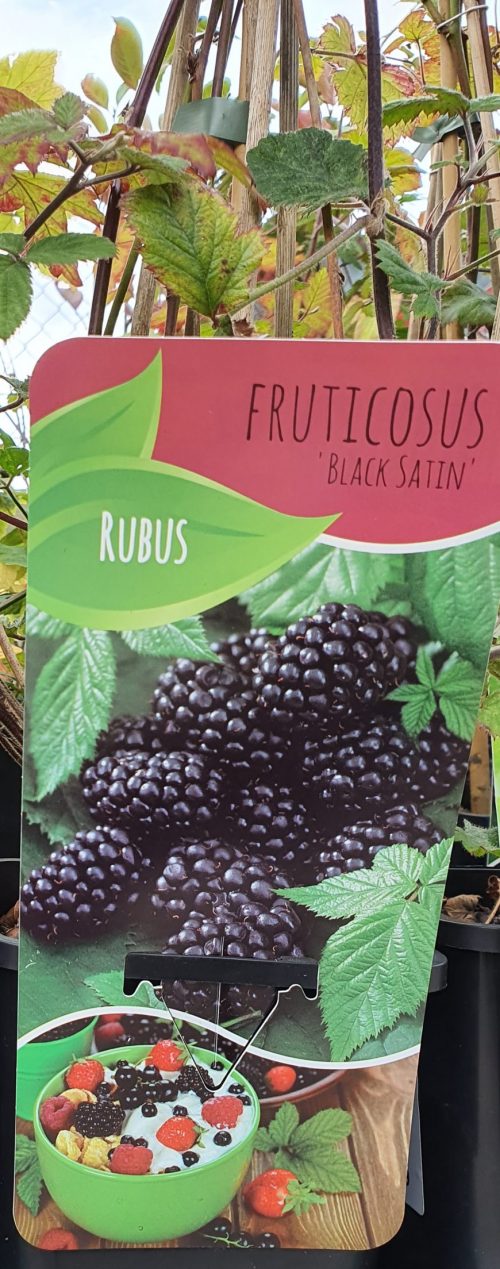
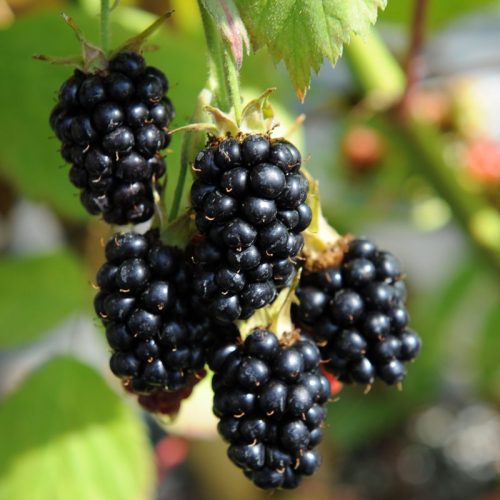 A thornless, American-bred blackberry, Rubus fruticosus Black Satin produces medium to large, rounded, black very juicy berries with a delicious, rather sharp flavour from late July, earlier than most thornless blackberries. Beautiful pale pink flowers and fruit are borne on two-year-old wood; yields are high and reliable. Blackberry Black Satin is a deciduous shrub with upright canes, to 10’/3m, which should be tied into post and wire supports or wires on a warm wall or fence to keep the plant from running rampant and make harvesting easier; cut down fruited canes and tie in new growth after the harvest. Good plant for pollinators. Site: Warm, sheltered, sunny site Soil: Any reasonable, well-drained soil, preferably neutral Position: Full sun Pick: From late July and through August Keep: Fruit does not keep, but freezes well Hardiness: Fully hardy Pollination: Self-fertile Uses: Eating fresh, cooking, preserving
A thornless, American-bred blackberry, Rubus fruticosus Black Satin produces medium to large, rounded, black very juicy berries with a delicious, rather sharp flavour from late July, earlier than most thornless blackberries. Beautiful pale pink flowers and fruit are borne on two-year-old wood; yields are high and reliable. Blackberry Black Satin is a deciduous shrub with upright canes, to 10’/3m, which should be tied into post and wire supports or wires on a warm wall or fence to keep the plant from running rampant and make harvesting easier; cut down fruited canes and tie in new growth after the harvest. Good plant for pollinators. Site: Warm, sheltered, sunny site Soil: Any reasonable, well-drained soil, preferably neutral Position: Full sun Pick: From late July and through August Keep: Fruit does not keep, but freezes well Hardiness: Fully hardy Pollination: Self-fertile Uses: Eating fresh, cooking, preserving -
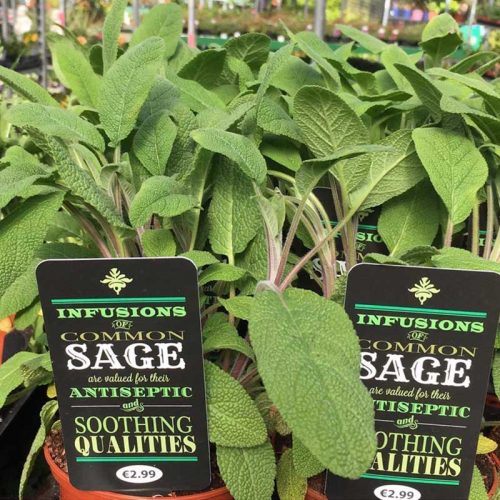 A yellow variegated form of sage. Used to flavour poultry and also popular in stuffing, sausages, roast, and strongly flavoured foods.
A yellow variegated form of sage. Used to flavour poultry and also popular in stuffing, sausages, roast, and strongly flavoured foods. -
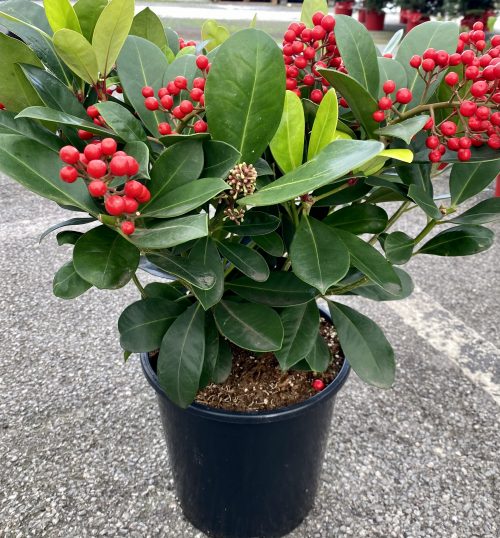 Skimmia Japonica 'Chameleon' has beautiful red berries right up to March/April and then white flowers will bloom for the summer. Perfect in sun or shade and can be kept in a pot or planted into the ground.
Skimmia Japonica 'Chameleon' has beautiful red berries right up to March/April and then white flowers will bloom for the summer. Perfect in sun or shade and can be kept in a pot or planted into the ground. -
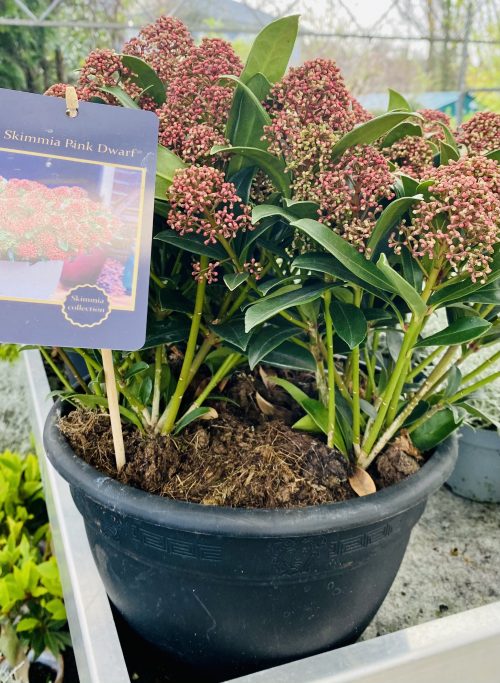 The Pink Dwarf is a compact growing Skimmia. Pink flower buds form in the autumn and and open to reveal pale pink flowers between March and May. Place in full sun/shade.
The Pink Dwarf is a compact growing Skimmia. Pink flower buds form in the autumn and and open to reveal pale pink flowers between March and May. Place in full sun/shade. -
Out of stock
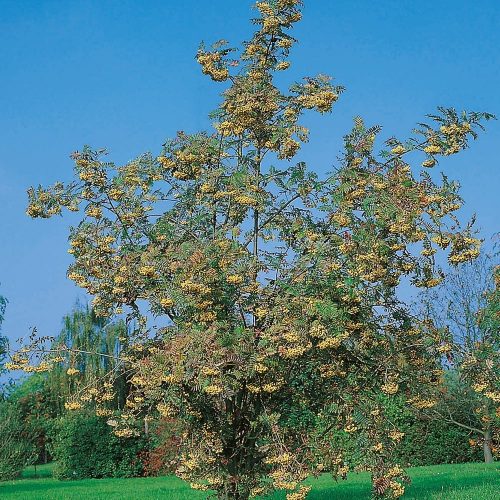
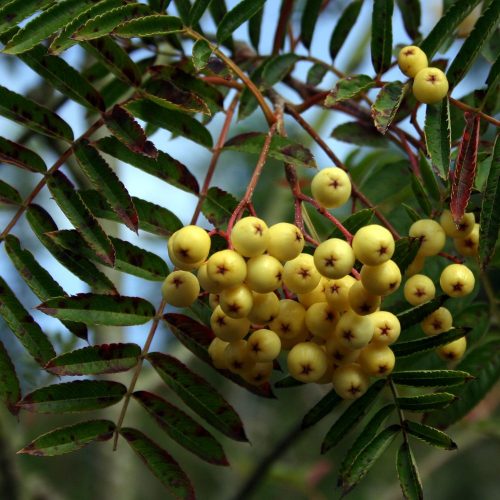 Sorbus Joseph Rock is a bright yellow-berried rowan tree very suitable for the small garden. It remains a great choice as a small tree for the small garden. A First-class tree with small, bright green leaflets that turn orange, purple and red in autumn. Clusters of white flowers appear in spring and are followed in autumn by small yellow berries, which birds love. It is an outstanding small tree which can tolerate a wide range of soils and conditions.
Sorbus Joseph Rock is a bright yellow-berried rowan tree very suitable for the small garden. It remains a great choice as a small tree for the small garden. A First-class tree with small, bright green leaflets that turn orange, purple and red in autumn. Clusters of white flowers appear in spring and are followed in autumn by small yellow berries, which birds love. It is an outstanding small tree which can tolerate a wide range of soils and conditions.- Max. Height & Spread: H-12m x S-8m
-
Out of stock
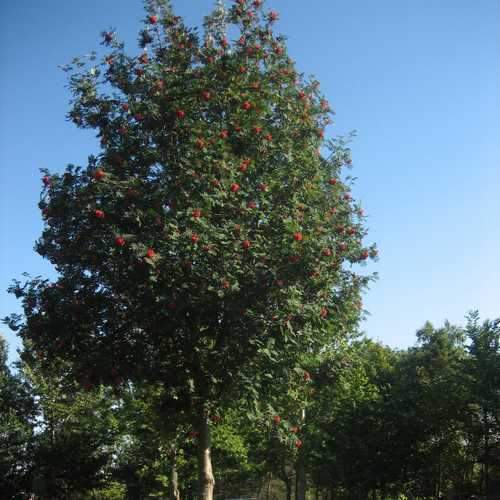
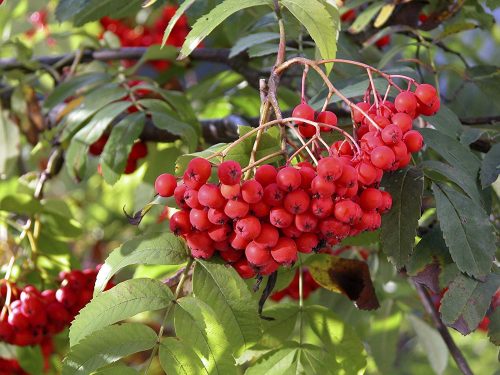 A cultivar of the native Irish rowan or mountain ash, Sorbus aucuparia ‘Sheerwater Seedling’ is a vigorous, medium-sized to tall tree of upright, narrow habit, the crown widening with maturity. It is often planted as a street tree. Creamy-white flowers appear in April–May, reliably followed by large clusters of long-lasting red berries in late summer. The leaves are grey-green, turning yellow and gold in autumn. A very easy, fast-growing, reliable tree, good for pollinators and birds. Plant in full sun for the best shape. Holds the RHS Award of Garden Merit. Site: Tolerates exposure Soil: Any reasonably well drained soil, acid to neutral soils preferred Position: Full sun Season of Interest: Spring, late summer, autumn Hardiness: Fully hardy Height: 40’ (12m) Spread: 13-26’ (4-8m)
A cultivar of the native Irish rowan or mountain ash, Sorbus aucuparia ‘Sheerwater Seedling’ is a vigorous, medium-sized to tall tree of upright, narrow habit, the crown widening with maturity. It is often planted as a street tree. Creamy-white flowers appear in April–May, reliably followed by large clusters of long-lasting red berries in late summer. The leaves are grey-green, turning yellow and gold in autumn. A very easy, fast-growing, reliable tree, good for pollinators and birds. Plant in full sun for the best shape. Holds the RHS Award of Garden Merit. Site: Tolerates exposure Soil: Any reasonably well drained soil, acid to neutral soils preferred Position: Full sun Season of Interest: Spring, late summer, autumn Hardiness: Fully hardy Height: 40’ (12m) Spread: 13-26’ (4-8m) -
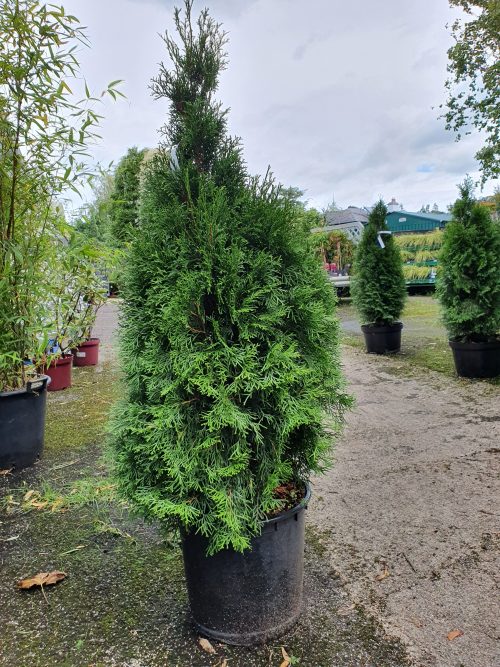 A slow growing, evergreen, erect conifer, Thuja occidentalis Smaragd has scale-like, fresh green leaves that are held closely to the shoots and give a fresh apple-like aroma when crushed. With its narrow, conical shape, Smaragd makes a useful tree for any garden, and is particularly suitable for formal plantings either as an individual specimen or in rows. It is slow to reach its eventual height of around 8-10ft but the narrow, conical shape will broaden out with maturity to reach a diameter of around 6ft. Pot size: 20L Actual height: 100-125cm Site: Very tolerant of inland exposure Soil: Well drained, tolerates clay soils, shallow over chalky soils Position: Full sun, tolerates partial shade Season of Interest: All year round and aromatic foliage Hardiness: Fully hardy Height: 5-8ft (1.5-2.5m) Spread: 3-6ft (1-2m)
A slow growing, evergreen, erect conifer, Thuja occidentalis Smaragd has scale-like, fresh green leaves that are held closely to the shoots and give a fresh apple-like aroma when crushed. With its narrow, conical shape, Smaragd makes a useful tree for any garden, and is particularly suitable for formal plantings either as an individual specimen or in rows. It is slow to reach its eventual height of around 8-10ft but the narrow, conical shape will broaden out with maturity to reach a diameter of around 6ft. Pot size: 20L Actual height: 100-125cm Site: Very tolerant of inland exposure Soil: Well drained, tolerates clay soils, shallow over chalky soils Position: Full sun, tolerates partial shade Season of Interest: All year round and aromatic foliage Hardiness: Fully hardy Height: 5-8ft (1.5-2.5m) Spread: 3-6ft (1-2m) -
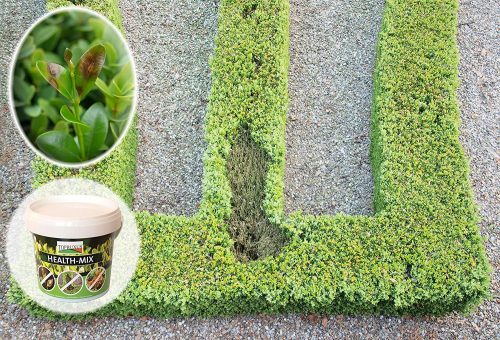
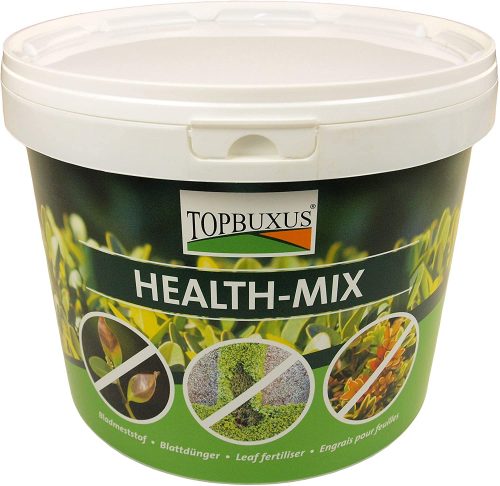 TOP BUXUS HEALTH-MIX can be used in two ways. 1. For bright green shiny leaves and to prevent fungal disease, such as Cylindrocladium With TOPBUXUS HEALTH-MIX, you can give your box plants bright green shiny leaves, preventing yellow edges and faded colours. To achieve this, treat your box plants 3-5 times during the growing season from March to October. This will also make your box plants healthier and stronger, resulting in them becoming more resistant to disease, etc.; this will particularly help to prevent fungal diseases such as Cylindrocladium. 2. To deal immediately with an acute fungal disease such as Cylindrocladium With TOPBUXUS HEALTH-MIX, you are able to immediately stop acute fungal disease such as Cylindrocladium. An acute fungal disease is immediately recognisable from the brown points that will swiftly expand to form blemishes. The most dangerous period is when there is protracted rainfall in combination with high temperatures. If you do nothing, the diseased box plant will soon start to lose its leaves and, in the worst case, if you fail to treat it, the affected branches can die, resulting in dead areas in your box plant. The diseased plants will then unfortunately have to be replaced. However, if you promptly use TOPBUXUS HEALTH-MIX after treatment, leaves will soon sprout on the diseased branches and recover. When the onset of disease is evident, immediately carry out the treatment. Under normal circumstances, one treatment is sufficient. It is extremely important to also immediately treat all of your healthy box plants. Should the warm and damp weather persist, repeat the treatment after 1 week. Thorough inspection is recommended in the future, particularly when the weather is warm and damp for protracted periods of time. If necessary, at a later date, you can simply repeat the treatment; this means you will continue to get maximum pleasure from your box plants. Do not use above 25 degrees Celsius. Only use early in the morning or evening in warm, sunny weather Can be used in damp weather, but preferably for use on dry foliage. If seriously affected with lots of brown spots and shedding leaves, we recommend that you first prune the plants considerably and then treat them straight away with TOPBUXUS HEALTH-MIX, which will encourage rapid regrowth
TOP BUXUS HEALTH-MIX can be used in two ways. 1. For bright green shiny leaves and to prevent fungal disease, such as Cylindrocladium With TOPBUXUS HEALTH-MIX, you can give your box plants bright green shiny leaves, preventing yellow edges and faded colours. To achieve this, treat your box plants 3-5 times during the growing season from March to October. This will also make your box plants healthier and stronger, resulting in them becoming more resistant to disease, etc.; this will particularly help to prevent fungal diseases such as Cylindrocladium. 2. To deal immediately with an acute fungal disease such as Cylindrocladium With TOPBUXUS HEALTH-MIX, you are able to immediately stop acute fungal disease such as Cylindrocladium. An acute fungal disease is immediately recognisable from the brown points that will swiftly expand to form blemishes. The most dangerous period is when there is protracted rainfall in combination with high temperatures. If you do nothing, the diseased box plant will soon start to lose its leaves and, in the worst case, if you fail to treat it, the affected branches can die, resulting in dead areas in your box plant. The diseased plants will then unfortunately have to be replaced. However, if you promptly use TOPBUXUS HEALTH-MIX after treatment, leaves will soon sprout on the diseased branches and recover. When the onset of disease is evident, immediately carry out the treatment. Under normal circumstances, one treatment is sufficient. It is extremely important to also immediately treat all of your healthy box plants. Should the warm and damp weather persist, repeat the treatment after 1 week. Thorough inspection is recommended in the future, particularly when the weather is warm and damp for protracted periods of time. If necessary, at a later date, you can simply repeat the treatment; this means you will continue to get maximum pleasure from your box plants. Do not use above 25 degrees Celsius. Only use early in the morning or evening in warm, sunny weather Can be used in damp weather, but preferably for use on dry foliage. If seriously affected with lots of brown spots and shedding leaves, we recommend that you first prune the plants considerably and then treat them straight away with TOPBUXUS HEALTH-MIX, which will encourage rapid regrowth -
Out of stock
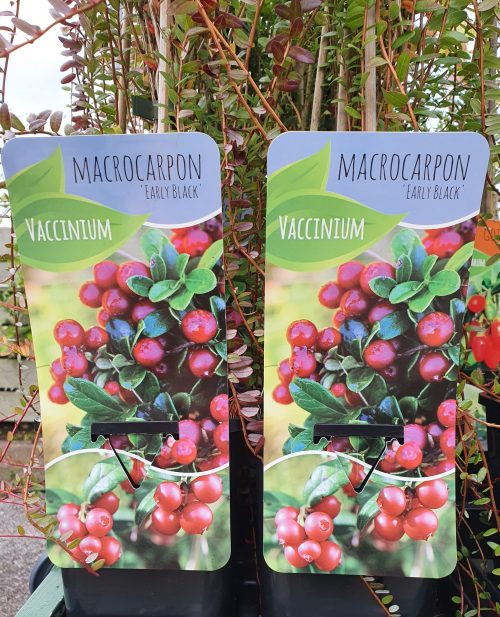
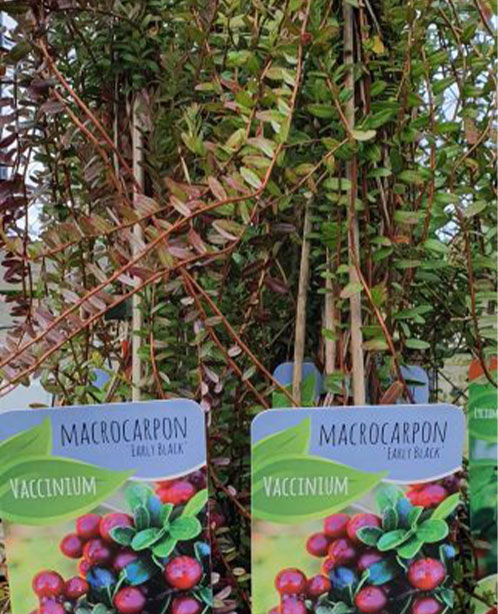 The fruits of 'Early Black' aren't actually black - starting off bright red they ripen to a deep purple-red that could easily be mistaken for black. But it certainly lives up to the 'Early in its name, cropping from late August - which makes it the earliest variety. High in Vitamin C, the fruits can be made into pies and puddings, crushed and made into juice, or made into Cranberry Jelly - perfect for the Christmas Turkey! Growing to a maximum of around 2 feet (60 cm) tall, this small evergreen bush does best in a full sun or a semi-shade position where it can be allowed to scramble as it wishes. Harvest from late August. Suitable for both open ground or container growing. For open ground planting plant 12" x 12" (30 x 30 cm) apart. Ericaceous, so will require soil or compost of an acidic nature. Self-fertile.
The fruits of 'Early Black' aren't actually black - starting off bright red they ripen to a deep purple-red that could easily be mistaken for black. But it certainly lives up to the 'Early in its name, cropping from late August - which makes it the earliest variety. High in Vitamin C, the fruits can be made into pies and puddings, crushed and made into juice, or made into Cranberry Jelly - perfect for the Christmas Turkey! Growing to a maximum of around 2 feet (60 cm) tall, this small evergreen bush does best in a full sun or a semi-shade position where it can be allowed to scramble as it wishes. Harvest from late August. Suitable for both open ground or container growing. For open ground planting plant 12" x 12" (30 x 30 cm) apart. Ericaceous, so will require soil or compost of an acidic nature. Self-fertile. -
Out of stock
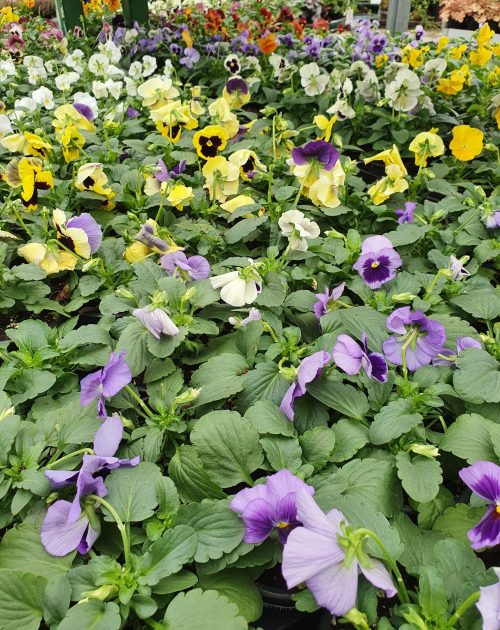
Pansy
The most popular and best loved. It will perform in your garden whether in a container or planted out into the borders etc. Totally Winter hardy. Flowers from end August - next August (if looked after!) Typically the pansies are termed as Winter pansies and will flower through the Winter providing there are plenty of sunny days. They require the sun to initiate flower bud and in the sometimes dreary, dull days that Winter offer they maybe shy to flower. The reward is usually around the end of February onwards the first Spring flush of vibrant colours lift the garden into joy. Unlike a lot of bedding plants, pansy & especially viola are easy to keep looking good providing a few basics are given. Watering is best done in morning, keep drier during the winter months - but at the same time don't let them dry out completely. Feed with a high potash feed such as vitax , once established. If you are time strapped we suggest adding slow release food in the compost at time of planting with Vitax Q4 or Gro-Sure. This should provide enough nutrient for 6 months, but frequency of watering may effect this. De-head regurlarly to keep the plant producing more flowers and for disease prevention. The smaller violas are self-cleaning, ie. de heading not neccessary. Pest & disease problems? If the plants are kept healthy with good watering and de heading & dead leaf removal the plants will be trouble free. Pests. Caterpillars are the main issue. If you are environmentally minded, pick off any you see. However, a spray with systemic insecticide will do the trick. Slugs can often eat the flower buds, leaves & stems so watch out for them. Disease. There can be leaf spot and downy mildew problems. This mainly happens if we get a dull wet Winter. Try to keep plants dry and remove any affected leaves straight away. Preventitive fungicides can work if applied correctly. -
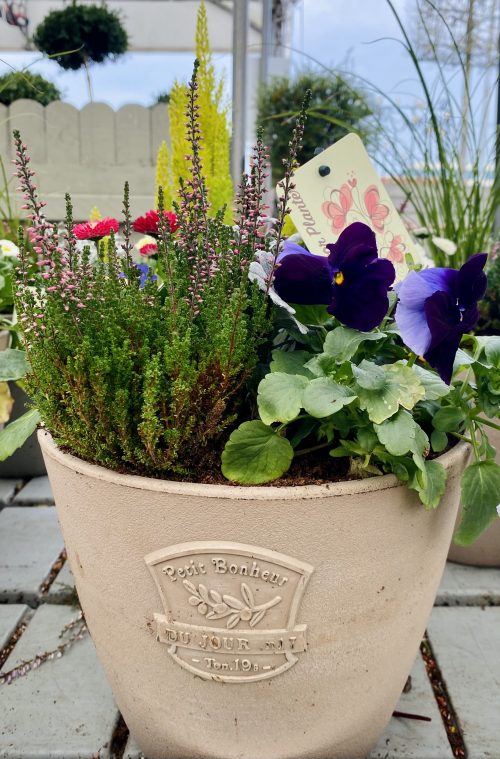 Winter planted containers hold a variety of winter bedding such as Cyclamen, Pansies and Heathers. Perfect to add a pop of colour to your garden this winter. Ideal for small gardens and terraces or to add a bit of character near your front door. These plants will stay in flower until Jan/Feb.
Winter planted containers hold a variety of winter bedding such as Cyclamen, Pansies and Heathers. Perfect to add a pop of colour to your garden this winter. Ideal for small gardens and terraces or to add a bit of character near your front door. These plants will stay in flower until Jan/Feb.